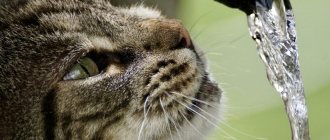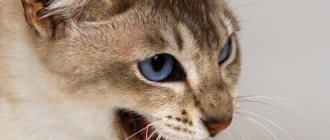Why do cats climb into boxes?
It is difficult to understand a cat's psyche, moods and desires. It is difficult to study them, as well as to understand the results of experiments conducted on them. However, research has revealed the following - murks strive for secluded places, looking for comfort and safety.
Research is good, but as know-it-all cat owners, we are no less curious and also want to know why cats like to sit in boxes and bags, considering all the possible options. Let's start with the simplest versions.
Ambush game
When a cat hides, we perceive it as just another prank. The little predator doesn’t think so; he is now catching his prey. You can’t escape instinctual needs, and our cat’s distant ancestors got their food from ambush. Why is the box not a shelter for a surprise attack? So the pet lurks, preparing to pounce. If you want to check, walk past the shelter and with a high degree of probability a lightning attack will be made on your leg.
Ear for music
I think many people have noticed that cats love rustling objects. You know why cats and cats like boxes - right, because of their wonderful rustling sound.
You can often notice that a pet, having taken a fancy to a bag or cardboard shelter, begins to dig and bite corners there. By the way, cats love to chew on boxes for the same reason. And if you do this inside, the sound is also amplified due to the echo.
Hide and seek from society
The cat is not a strategist in the field of resolving conflict situations. It is easier for her to avoid meeting a possible enemy. That's why cats climb into boxes not to solve problems, but to hide from them. But even in a great mood, Murka also does not shy away from cardboard fun.
Personal space
If you are wondering why cats love boxes, then it will not hurt to know that for a pet, having personal space is just as important a factor as for a person. Having taken a fancy to a cardboard shelter or even a package, the pussy “settles in” in its place, a personal room, saturated only with its aromas. So, if you notice that your pet’s interest in the box is more than idle, arrange a home for him. A warm pillow along with a favorite toy will take your cat to the skies.
The smell of cardboard is a habit
Cats are often housed in boxes after lambing. In this case, the smell of cardboard is one of the first, and therefore familiar, aromas that the kitten remembers. In addition, the smell of childhood reminds a purring mother. In addition, the boxes are made of paper, which, in turn, is made of wood - a natural material that reminds your pet of wild roots. This is especially true for cats that are never outside.
Feeling of security
It may sound ridiculous, but cats' love of solitude and boxes is often based on this factor. Conduct an experiment, place several boxes of different sizes in front of your pet, and he will definitely climb into the one that is ideal for him in size. But even if there is nothing suitable for the dimensions of the mustache, he will make every effort to fit there at least partially.
It is believed that cats completely relax in boxes. Instincts tell the pet that a dense environment is protection, similar to natural shelters, such as a hollow in a tree.
Why do cats like to sit in boxes and people like to look at it? But this is a whole lot of fun not only for the fluffy one, but for all family members. The performance can be made even more colorful if you use your imagination. Cut several different holes in the box or build a cat house out of cardboard and see how enthusiastically your pet will begin to master the new structure.
Rusting sounds
Sound is of great importance to a cat. Any plastic bag rustles, and this attracts the animal's attention. Firstly, because there are not many unusual sounds in the life of a domestic cat. Secondly, because in nature prey often rustles. Mice and other rodents scratch in their burrows and rustle in the grass as they run through it. Cats automatically respond to sound. If it rustles, it means you have to catch it. And then either eat or play.
Boxes, unlike soft beds, also make a similar sound - and from the cat’s point of view, this is an extra plus in their favor. This reminds us of nature, where everything makes some sounds - the grass on which the cat is trying to lie down, and the branch along which it is walking, and many other things.
Admit it, you, too, would not resist something pleasant and rustling. Millions of people cannot stop eating the soft and rustling film with pimples. Cats have their own analogue.
The main thing is not to let your cat play with a small bag that smells like something tasty to her. There is a high probability that she will start licking him and even eating him. And a swallowed bag or film is one of the worst things that can happen to a cat’s stomach, right after needles and other sharp objects.
Why do cats and cats like bags?
You may quite rightly ask why cats like bags. After all, if everything is already clear with the box, then what attracts the pet to the rustling device for transporting things. The answer to this question is as simple as in the situation with boxes:
- a game
- curiosity
- opportunity to hide
In addition, we often bring food home in bags, and all cats certainly like it. Animals are attracted to the smell of food or the street. So they run around with the bag, enjoying the pleasant aromas.
As you can see, cats’ love for boxes and bags is due to various reasons. Don’t think about them, just let the purr enjoy life and rejoice with it.
Desire for privacy
Cats are loners. In the wild, they do not live in herds and always defend their territory. They adapt quite easily to family life, but sometimes they still need the opportunity to retire, to feel like they are “at home.” And if people need a separate room for this purpose, then a small box is perfect for a cat. It allows you to simultaneously be isolated from other family members and continue to observe them.
Remember how you felt as a child when you built houses out of blankets and pillows, and you will perfectly understand the cat’s desire to lie down in a box!
Paper
Crumpled paper, often used as packaging material, can also be a cat's best friend. Don't be upset if you spent a decent amount of rubles on a beautiful cat house, but your pet prefers your newspaper or wrapping paper to it. This doesn’t happen often: apparently, they simply enjoy the process itself.
Maybe they are trying to get your attention with this behavior, or perhaps they want to mark their territory. Or is it a new item in the house that needs to be explored in more detail. Dangling objects seem to remind cats of hunting. In fact, there is no end to the speculation as to why your cat chose paper.
What to do?
Eating newspapers is dangerous for an animal's life.
A single use of ordinary paper sheets rarely causes harm to your pet's health, but a large lump can lead to intestinal obstruction. In this case, the cat may need surgery. Newspapers with printing ink are very dangerous, since the consequences of their use are serious intoxication of the body with ink and upset of the gastrointestinal tract. It is necessary to remove all sheets from the cat, and if the pet shows interest in it, hide the toilet paper in a recessed, closed holder. To ensure that giving up a dangerous habit goes smoothly, it is recommended to offer your pet an alternative, such as fresh grass. But you can’t take it on the street, as it can cause poisoning and gastrointestinal upset. You should grow weed on a windowsill. If the cat’s behavior is dominated by the desire to play with paper pieces, then she needs to buy balls, artificial mice, or make toys herself. But when a pet is purposefully looking for sheets, pieces of a box, newspaper to eat, you need to examine its oral cavity. The specific smell of pus, bleeding gums and rotten teeth signal the need to visit a veterinarian. If problems are confirmed, it is recommended to carry out ultrasonic cleaning of the enamel and temporarily abandon wet food, which creates an environment in the mouth suitable for the proliferation of pathogenic microorganisms. It is better to give preference to dry food. If the animal is on a natural diet, then its diet should be enriched with cereals, vegetables, and fermented milk products of medium fat content.
Warm
The boxes also attract four-legged creatures by providing warmth when it gets too cold outside. Cats can't just put on a sweater when the temperature drops, so don't be surprised if they seek warmth in unusual places. Cardboard is an excellent insulator. Whether your cat is stressed, mildly ill, or just looking for a comfortable place to feel safe from predators (perhaps your neighbor's dog), a box is a very suitable item.
Other sensations
It is also noted that the sound from the bag may remind pets of the noise emanating from rodents when they run through fields or other objects. They understand this: rustling means prey. They can be attracted by various acoustic signals. So don’t be surprised by this behavior of your pet.
Moreover, according to scientific point of view, your pet is a mammal of the cat family of carnivores. So what you are observing is their natural behavior. Cats are small predators, and you shouldn't teach them something like that.
Scientific research
This question has interested even the scientific minds of our world for a very long time, and there are a huge number of versions on this subject. The famous Dutch veterinarian Claudia Vinck has been studying the behavior of cats in shelters for a long time. The decisive experiment in her work was the experiment with newly arrived animals that were still in a state of stress. Wink seated them in two different rooms, one of which was equipped with various hiding places, and the other remained free for prying eyes. As a result, animals with the opportunity to be left alone with themselves adapted to new living conditions much faster.
The result of the study was confirmation of the opinion that it is easier for cats to run away and hide from problems than to solve them, regardless of their size and habitat.
Matter of habit
A special opinion about why cats like boxes is the version that humans artificially instilled this habit in them. The thing is. that domestic cats most often give birth to their offspring in cardboard containers, and therefore, the smell of this material becomes familiar to kittens from birth.
It is from the very first days that animals associate the aroma of cardboard with warmth, comfort and security, and so that your pet loves to sit in your arms with the same intensity, you can try to accustom him to this from childhood.
Finding a safe place
The way of life requires animals to find a safe shelter. Wild cats sleep most of the day. This is how predators save the energy needed for hunting. While resting, they need a safe place, protected from other animals. In nature, they climb trees, find holes, and hide in bushes.
At home, pets do not require such tricks. But instinct pushes us to search for shelter, explaining why cats love boxes and bags.
Even a small object seems like a suitable place for them to hide. A cat can settle into a box that only fits its paws and feel comfortable. The pet is calmed by the presence of limited space. Scientists have shown that access to boxes reduces stress in pets.
Shelter provides a feeling of security - the cat understands that it will not be attacked from behind or from the side. All potential threats must be brought into view.
An enclosed space becomes a cozy couch. But only if the cat got there voluntarily. Forcible attempts to place your pet in a carrier or bag will be met with aggression. But the cat can explore the same container on its own and choose it for sleeping or resting.
It is worth giving mousecatchers a choice of several hiding places. When bringing a cat home for the first time, it is advisable to release:
space under the bedside table (table);
a place in a closet with an easy-to-open door.
The animal will choose the offered shelter or find its own. So, the cat will hide in a constantly forming pile of clothes for ironing, a box under a folding chair (sofa). The presence of stationary shelters will not affect the interest in abandoned boxes (packages).
The curiosity that boxes and bags evoke
The packaging brings an abundance of smells. This is one of the reasons why cats lick bags. They also leave traces of the contents. Animals are attracted to the smell:
So, a cat will climb into a box of bleach, a product containing chlorine. Pets are attracted to new scents, especially those containing traces of other animals. The cat will show increased interest in a country box, a bag that has been in contact with the local fauna.
For pets, packaging becomes a source of information about the outside world. The contents, places of injury and production leave aromatic traces that can interest the pet. Having climbed into the box, the cat receives information about other places without leaving the room (yard).
Hunting or game
Entertainment is an additional reason why cats lick bags. In addition to food debris, the material attracts them by rustling and pliability on the claws. A cellophane bag becomes a favorite toy until it becomes unusable. Attracted by a scent or hiding space, the cat climbs into the bag.
The rustling light material is an interesting prey. The cellophane moves with a slight blow or push, prompting the animal to enter into a “fight.” Cats also see other packaging as a potential toy. How they are attracted to a surface for sharpening their claws:
- polystyrene foam, other foamed plastic;
soft woods.
The materials are used to produce containers where cats can hide: completely or “nominally”, climbing into a box without a lid or a box with large holes. From a hiding place, the pet can hunt others. Structures made of soft materials allow for additional improvement of the shelter. The pet tears off pieces of the structure, creating additional toys; makes holes, creates grooves, sharpening claws.
Relevance
We cannot explain every special behavior of cats. But this is not necessary: it is part of their charm, and observing their behavior in such situations brings us great pleasure. We humans are never sure if our cats really love us or just want free food and shelter.
So why do our four-legged friends, when they see some objects, completely forget about everything else? Whether it's a regular bag from the grocery store or a cardboard box from your friendly mailman, cats are quick to pounce on these things, making them their new toy, home, or even snack. What is the explanation for this habit? Let's find out.
The smell of food
First of all, we want to assure you: when faced with incomprehensible behavior of a pet, you should not assume that he has rabies. In this state, the cat will rush at the person, and not at the box or plastic bag.
Scientists and pet lovers alike have several theories as to why kittens go crazy over these items. One of the most obvious explanations is that these bags or boxes previously contained food. Cats have a keen sense of smell (much stronger than that of any human), so it is not surprising that they can sniff the entire package that, for example, previously contained a frozen salmon fillet. Additionally, many of these bags are coated with natural material (such as cornstarch) and some are even made from animal by-products (gelatin). All this makes such items especially attractive and tasty.











